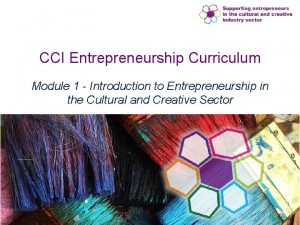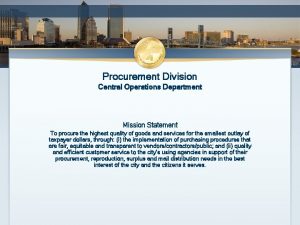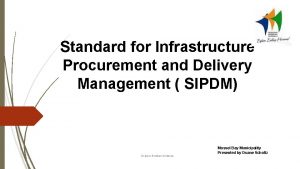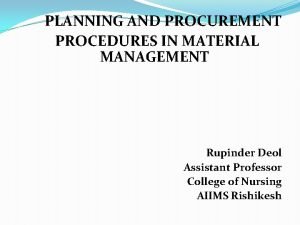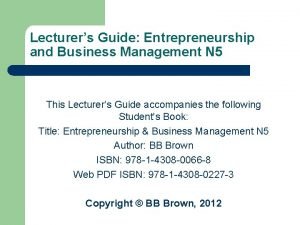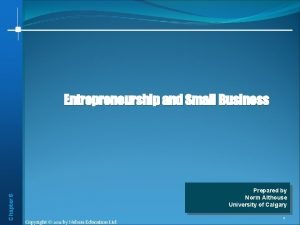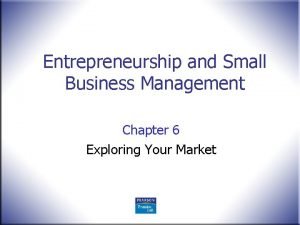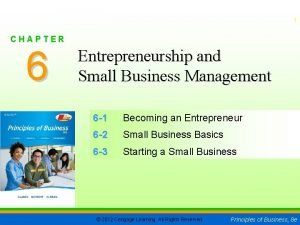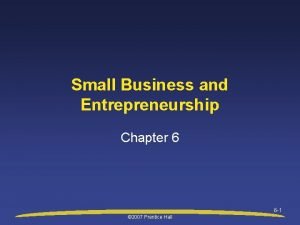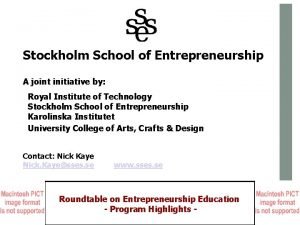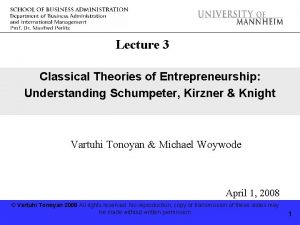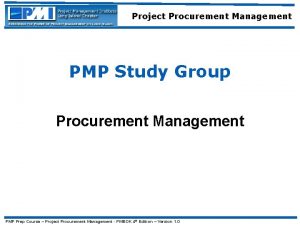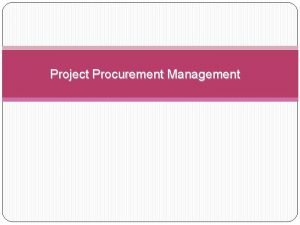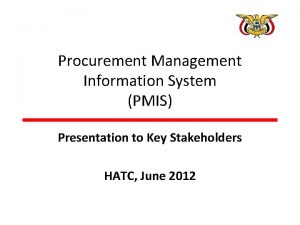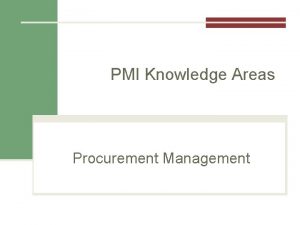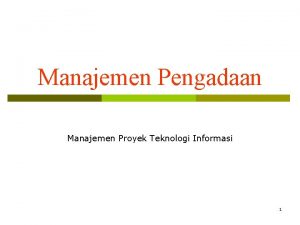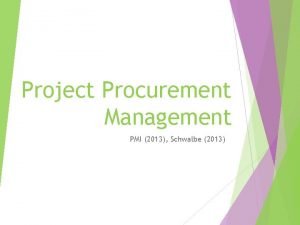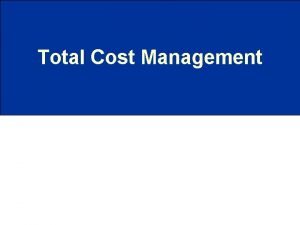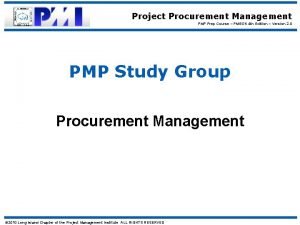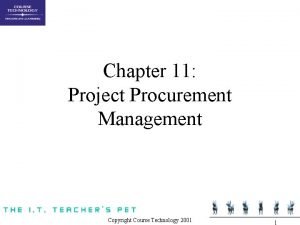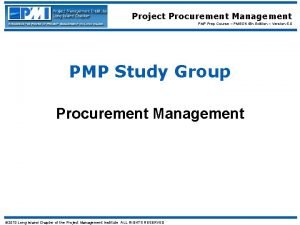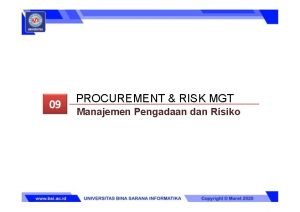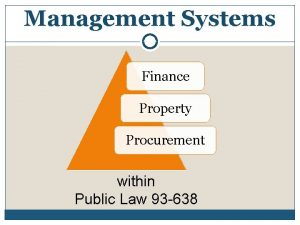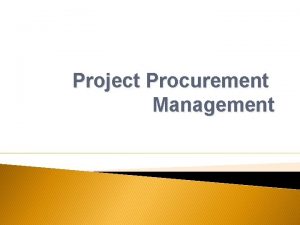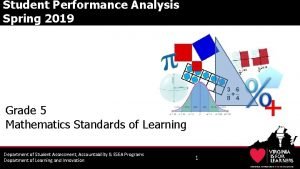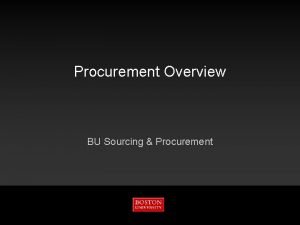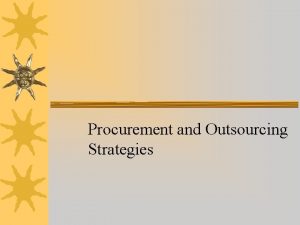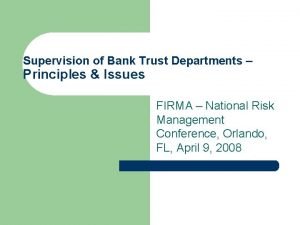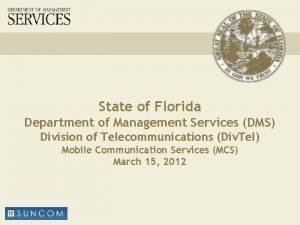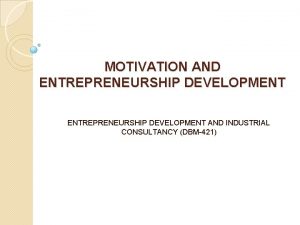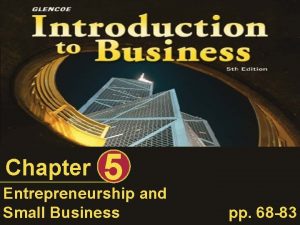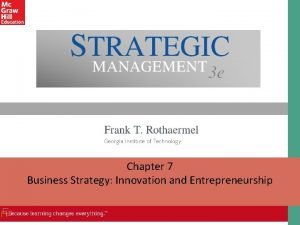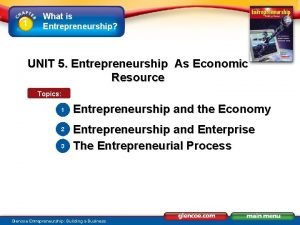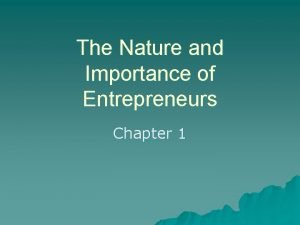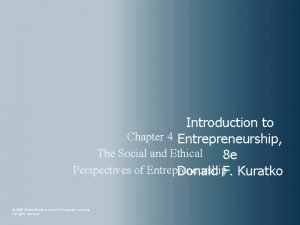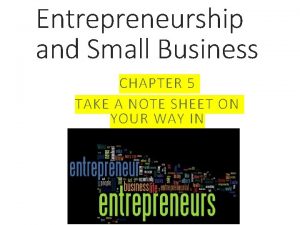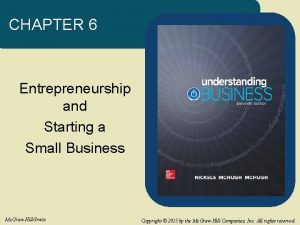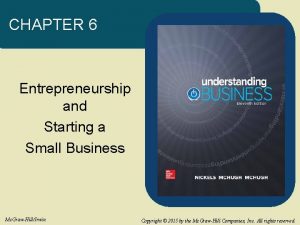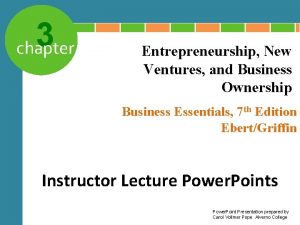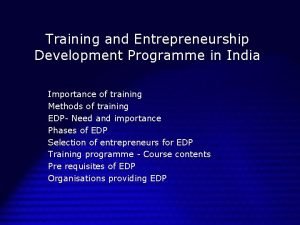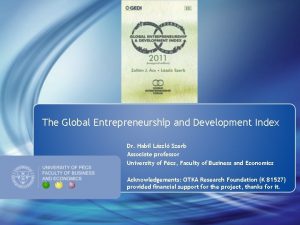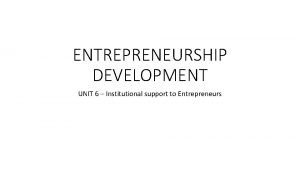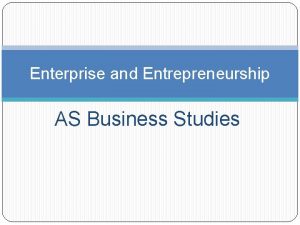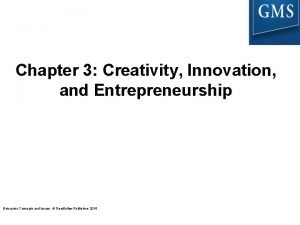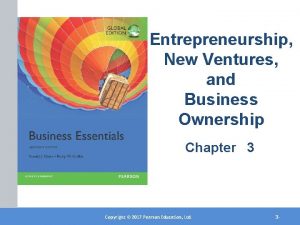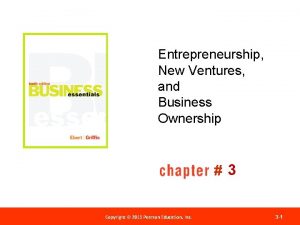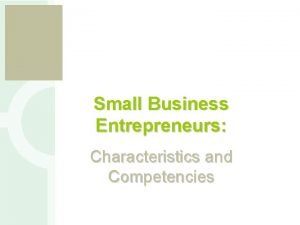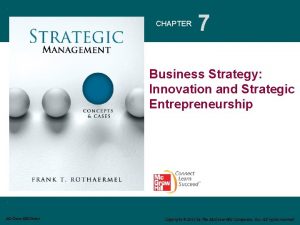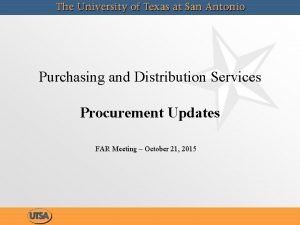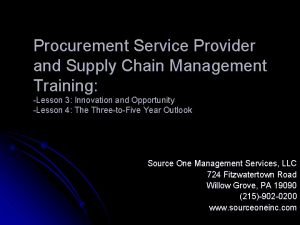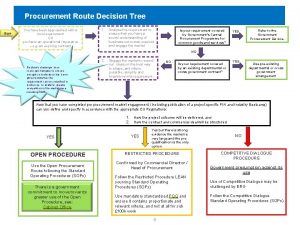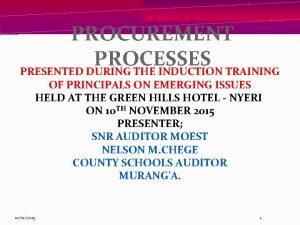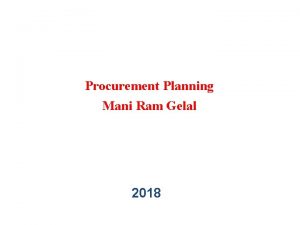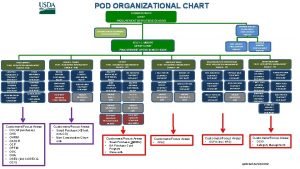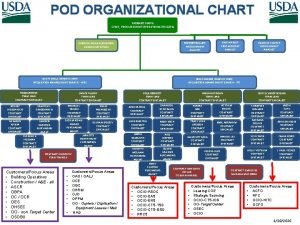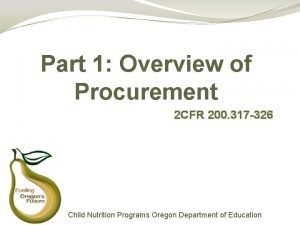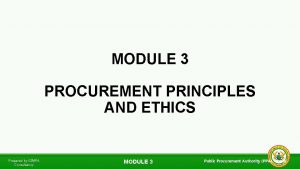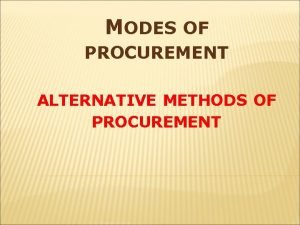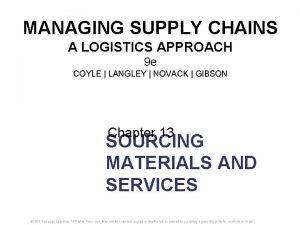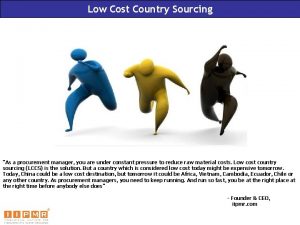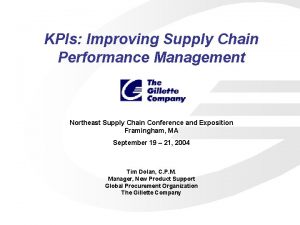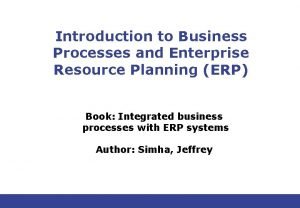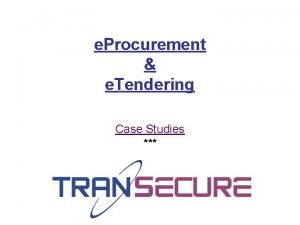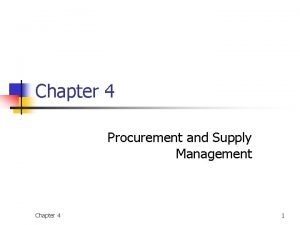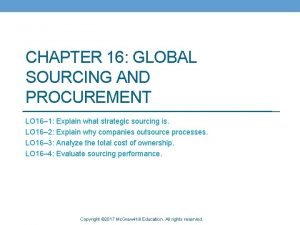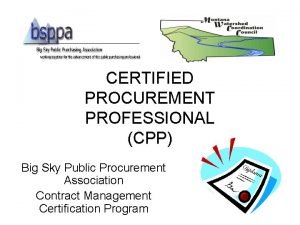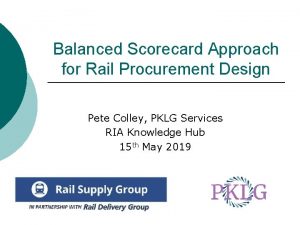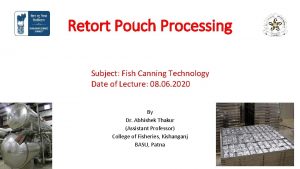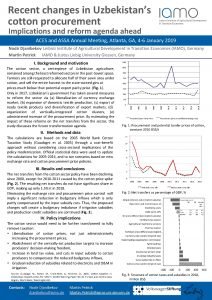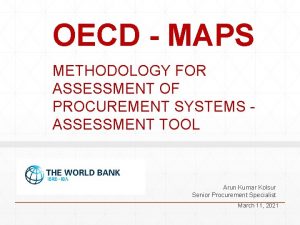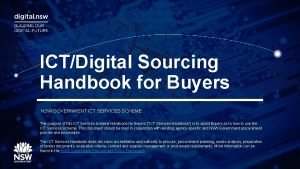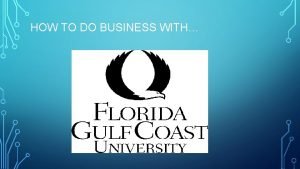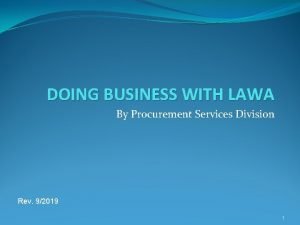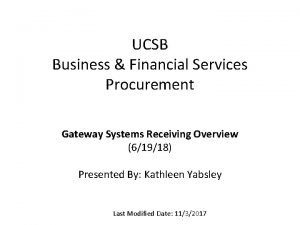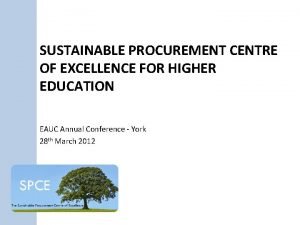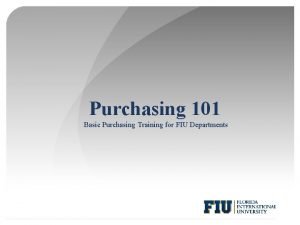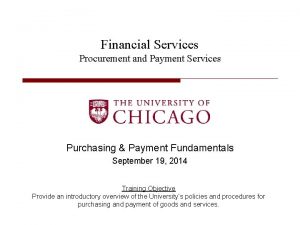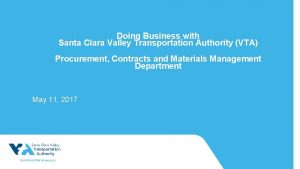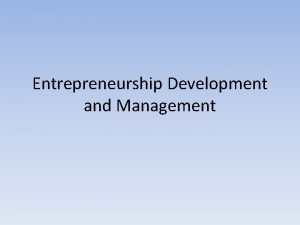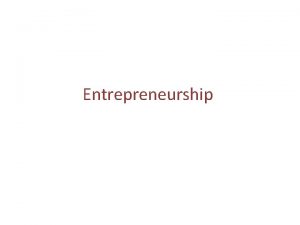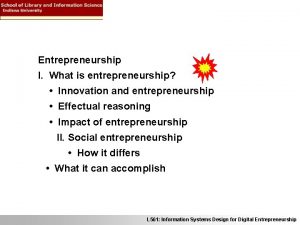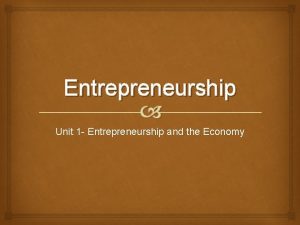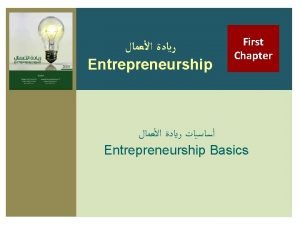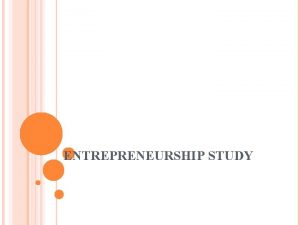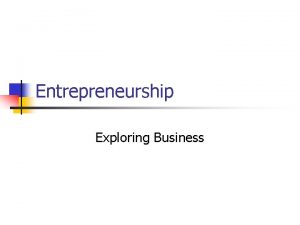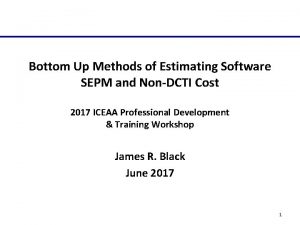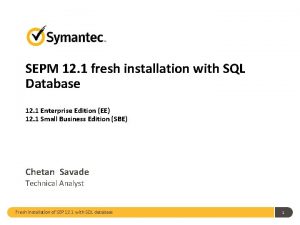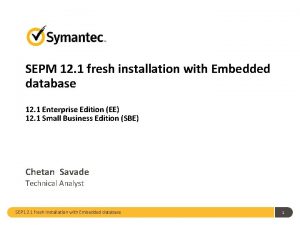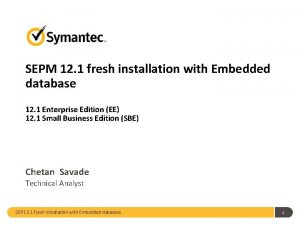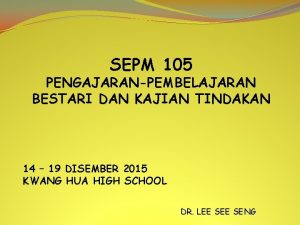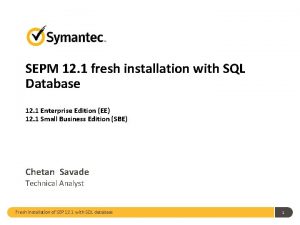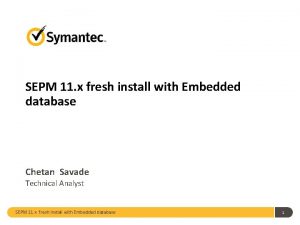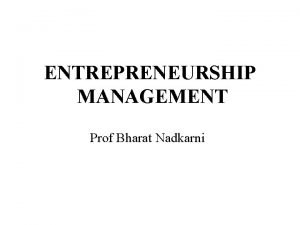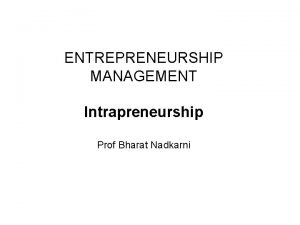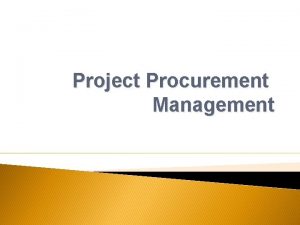School of Entrepreneurship Procurement and Management SEPM Department

































































































































































- Slides: 161

School of Entrepreneurship, Procurement and Management (SEPM); Department of Entrepreneurship and Technology, Leadership and Management (ETLM) Ph. D unit in Technology, , creativity and innovation Prof. Henry M. Bwisa bwihem@yahoo. com www. professorbwisa. com www. mukmik. co. ke 10/24/2021 HEPM 3112. Prof. Bwisa 1

• FIRST THINGS FIRST 24/10/2021 Prof. Bwisa H. M. 2

LET’S START BY SEARCHING FOR A DEFINITION FOR Ph. D

I spotted these street definitions …. P h D 24/10/2021 Harare Gaborone Nairobi Pull Pengine head her hana Damage Down Dikri Permanent Prof. Bwisa H. M. 4

On a more serious note we discovered that a Ph. D. is… • 1: A degree signifying expertise – Signifies the capability to conduct research – Some positions (e. g. , professor, research scientist, managers at govt labs, etc. ) only hire Ph. D. ’s – An entry card into a community of experts in some “area” – By the time one graduates with a Ph. D, one is known and respected as an expert in that area • What is an expert? Someone who knows more about some topic than anyone else (in the world!!!!!) 24/10/2021 Prof. Bwisa H. M. 5

What is a Ph. D? • 2: An opportunity for a certain lifestyle – To think for a living – To make a large impact on something – To be your own boss • Flexible hours • Flexible pace • Flexible topic – To travel – To constantly learn and attack new challenges – To make decent money 24/10/2021 Prof. Bwisa H. M. 6

So, what does Ph. D entail? ? ? • To earn a Ph. D. , one must accomplish two things: (1) master a specific subject completely, and (2) extend the body of knowledge about that subject. • To master a subject, a student searches the published literature to find and read everything that has been written about the subject. • The essence of a Ph. D. , the aspect that distinguishes Ph. D. study from other academic work, can be summarized in a single word: research. • To extend knowledge, one must explore, investigate and contemplate. 24/10/2021 Prof. Bwisa H. M. 7

• For Ph. D, Knowledge Production and Dissemination is key…. Individuals with a Ph. D: produce (research) and disseminate (teach) knowledge. Their pursuit of either may be mainly for the sake of (a) understanding, (b) use, or (c) a combination of (a) and (b). – Whatever the case Ph. D holders are the knowledge producers ; they are expected to live and work on the cutting edge, the frontiers of our knowledge. 24/10/2021 Prof. Bwisa H. M. 8

• • • What can one do with a Ph. D. ? Academia –Research faculty –Faculty at teaching university/college Industrial research lab National labs (government) Management consulting Start a company End of thinking capacity 24/10/2021 Prof. Bwisa H. M. 9

The philosophy and approach of this course The course will be conducted on Confucius’ (450 BC) philosophy of: • I hear and I forget • I see and I remember • I do and I understand 24/10/2021 Prof. Bwisa H. M. 10

THERE IS A CONE OF LEARNING THEORY AND MODEL DEVELOPED IN 1946 BY THE GREAT EDUCATOR DALE EDGAR 24/10/2021 Prof. Bwisa H. M. 11

I HEAR AND I FORGET I SEE AND I REMEMBER I DO AND I UNDERSTAND 24/10/2021 Prof. Bwisa H. M. 12

EXPERIENTIAL LEARNING DEVELOPED BY DAVID KOLB IN THE 1970 S AND PUBLISHED IN 1984 WHEN I WAS MIDWAY MY Ph. D 24/10/2021 Prof. Bwisa H. M. 13

• Teaching methodologies: Lecturers, group work and case studies. • Instruction materials/equipment: Lecturer manuals, Flip charts, Whiteboard, relevant computer soft and hardware. 1 EXPERIENCE Do 3 PROCESS 4 GENERALIZE 24/10/2021 to connect the experience to real world examples by discussing, locking at the experience; analyze, reflect Prof. Bwisa H. M. l Le ntia Apply Reflect arn the results, reactions, and observations publicly erie what was learned to a similar or different situation; practice ing 2 SHARE Exp 5 APPLY Mod el the activity; perform, do it 14

COURSE STRUCTURE ACTIVITY START-END DURATION % OF TOTAL TIME CLASSROOM LECTURES WEEK 1 -4 4 WEEKS 27 FIELD WORK WEEK 5 - 11 7 WEEKS 47 CLASS PRESENTATIONS WEEK 12 -14 3 WEEKS 20 EXAMINATION WEEK 15 1 WEEK 06 TOTALS WEEK 1 -15 15 WEEKS 100 GUIDED AND 24/10/2021 BY CONFUCIUS, DALE Prof. Bwisa H. M. KOLB PHILOSOPHIES 15

Your assignments • Technology is developed by people to modify their environment. To develop the technology creativity is required. The technology developed must continuously serve the people. This requires continuous innovations

For your CAT • In a group of not more than two, You will creatively use the SCAMPER creativity technique to design an innovative solution to an identified problem and present it in class. The innovation must be patentable.

For your end of semester examination Working in the same groups you will apply the Rogers’ innovation characteristics to justify that the innovation will be adopted by consumers and write an application to patent it

• Towards your assignments 24/10/2021 Prof. Bwisa H. M. 19

Attributes of Innovations The characteristics of innovations, as perceived by individuals, help to explain their different rates of adoption 1. Relative Advantage: Degree to which an innovation is perceived as better than the idea it supersedes. 2. Compatibility: Degree to which an innovation is perceived as being consistent with the existing values, past experiences, and needs of potential adopters. 3. Complexity: Degree to which an innovation is perceived as difficult to understand use. 4. Trialability: Degree to which an innovation may be experimented with on a limited basis. 5. Observability: Degree to which the results of an innovation are visible to others 6. Re-inventability: Degree to which an individual’s use of a new idea departs from the core or “mainline” version of innovation promoted by a change agency (Eveland et al. , 1977) Innovations that are perceived by individuals as having greater relative advantage, compatibility, trialability, observability, re-inventability and has less complexity will be adopted more rapidly than other innovations 10/24/2021 20

Product characteristics that influence diffusion Characteristics Relative advantage Compatibility Definition Degree to which potential customers perceive a new product as superior to existing substitute. Eg. HDTV over standard TV Degree to which potential consumers feel a new product is consistent with their present needs value and practices Eg. Gillete Mach 3 Turbo over disposable razor

Product characteristics that influence diffusion Characteristics Definition Complexity Degree to which a new product is difficult to understand or use E. g. Disposable razors Trialability Degree to which a new product is capable of being tried on a limited basis E. g. Free trial software Observability Degree to which a products attributes can be observed, imagined to potential customers. E. g. Laptop

The scamper technique



SCAMPER – Tool for Innovation 24/10/2021

SCAMPER – Tool for Innovation 24/10/2021

SCAMPER – Tool for Innovation Substitute white board for black board 24/10/2021

SCAMPER – Tool for Innovation Substitute Kerosene with solar power 24/10/2021

SCAMPER Eliminates smoke Substitute Coal with biomass pellets Oorja Stove 24/10/2021 http: //www. growthinstitute. in/emagazine/jun 10/innovations. html

SCAMPER – Tool for Innovation 24/10/2021

SCAMPER Combine 24/10/2021 fork with – sticks or spoon

SCAMPER Combine 24/10/2021 Wash basin + flush tank!

SCAMPER – Tool for Innovation Combine shampoo+ oil 24/10/2021

SCAMPER – Tool for Innovation Combine fridge + table 24/10/2021 http: //worldmustbecrazy. blogspot. in/2010/11/mini-f-space-saving-refrigerator. html

SCAMPER Combine 24/10/2021 table, couch, storage http: //dornob. com/transforming-table-turns-into-a-luxury-leather-couch/

SCAMPER – Tool for Innovation 24/10/2021

SCAMPER Adapt Sofa made into twin beds 24/10/2021 http: //inhabitat. com/bonbon-convertible-doc-sofabunk-bed/bonbon-doc-couch/

SCAMPER – Tool for Innovation Adapt car doors mimic bird’s wings 24/10/2021

SCAMPER – Tool for Innovation Adapt Seat belt with inflatable air bags for rear seats http: //www. autotrends. org/2009/11/05/nifty-idea-inflatable-seat-belts/ 24/10/2021

SCAMPER – Tool for Innovation 24/10/2021

SCAMPER – Tool for Innovation Magnify Minify Stretch Limousine Laptop computers 24/10/2021

SCAMPER Modify Wheelchair entry through the back. One hand steering wheel. Rails and handles on the sides. Electric mobile vehicle. 24/10/2021 http: //evworld. com/news. cfm? newsid=32048

SCAMPER – Tool for Innovation 24/10/2021

SCAMPER Put to other use CD Drive as a clock Source: http: //www. ecofriend. org/entry/eco-friendly-desktop-clock-with-a-cd / 24/10/2021

SCAMPER Put to other use Ball bearing as a watch. 24/10/2021 Source: http: //rbibearing. com/2014/02/05/innovative-uses-for-ball-bearings/

SCAMPER Put to other use stall made of crates 24/10/2021

SCAMPER Put to other use 24/10/2021 http: //ecoartsblog. wordpress. com/

SCAMPER Waste need not be wasted! Put to other use Artistic products from scrap metal 24/10/2021 http: //ecoartsblog. wordpress. com/

SCAMPER – Tool for Innovation 24/10/2021

SCAMPER Eliminate adjustments Cords from telephones to make cellphone 24/10/2021

SCAMPER Eliminate chemical pesticides Israeli company Tamar Tech uses a blend of oils as a substitute for chemical pesticides http: //nocamels. com/tag/tamar-tech/ 24/10/2021

SCAMPER – Tool for Innovation 24/10/2021

SCAMPER – Tool for Innovation Reverse/Rearrange • motor run backwards = a generator 24/10/2021

SCAMPER – Tool for Innovation Reverse/Rearrange • exchange the position of the digital display and the buttons • buttons easier to press as they are larger • angled time display is easier to read 24/10/2021

SCAMPER – Tool for Innovation 24/10/2021

Nano Design - SCAMPER 2 -Cylinder Engine Adapt No Air-bag / AC / Power Windows Eliminate Adhesive for Welding Substitute Plastic for Metal Substitute 24/10/2021 Size just 10 ft X 5 ft Minimize

SCAMPER Rearrange Turn a chair into a table 24/10/2021 http: //dornob. com/fold-up-home-furniture-flip-flop-table-turns-into-a-chair/

• Your notes

What is technology? 10/24/2021 H. M. Bwisa (2012) 60

What is Technology? • The purposeful application of information in the design, production, and utilization of goods and services, and in the organization of human activities. Can be: • Tangible: physical objects. • Intangible: methods of doing things • High: entirely automated processes. • Intermediate: semi automated processers. • Low: labor-intensive technology

Technology and Innovation • Technology –“Knowledge of how to do things. ” –“The system by which a society satisfies its needs and desires. ” –“Capability that a firm needs to provide its customers the good and/or services the firm proposes to offer, now and in the future. ” 10/24/2021 H. M. Bwisa 62 (2012)

What is Technology? What Counts as Technology? There are “classes” of technology: 1. Technology as Objects: Tools, machines, instruments, weapons, appliances - the physical devices of technical performance 2. Technology as Knowledge: The know-how behind technological innovation 3. Technology as Activities: What people do - their skills, methods, procedures, routines 4. Technology as a Process: Begins with a need and ends with a solution 5. Technology as a Socio-technical System: The manufacture and use of objects involving people and other objects in combination 10/24/2021 H. M. Bwisa (2012) 63

What is technology? TECHNOLOGY HARDWARE SOFTWARE SYSTEM-WARE physical embodiments e. g. tools, equipment skills to make hardware work infrastructure to make hardware work e. g. institutions, legal framework LIVE-WARE technical and managerial skills 10/24/2021 INNOVATION-WARE know how to improve, add value, innovate H. M. Bwisa (2012) 64

The nature of Technology: it has a number of characteristics 10/24/2021 H. M. Bwisa (2012) 65

1. It is Related to Science? Science is concerned with understanding how nature and the physical world work. Science is a process by which we try to understand how the natural and physical world works and how it came to be that way. • You see something happen, you ask why? • You want to make something happen, you ask how? • Science is a tool for answering why and how. 10/24/2021 H. M. Bwisa (2012) 66

2. It Involves Design: . The design process begins with the perception of a need, to formulation of a specification, to the generation of ideas and a final solution, and ends with an evaluation of the solution. For the term “design process, ” we can also read “problem-solving process”. The process begins with the identification and analysis of a problem or need and proceeds through a structured sequence in which information is researched and ideas explored and evaluated until the optimum solution to the problem or 10/24/2021 H. M. Bwisa (2012) 67

3. It Involves Making: The motivating factor behind all technological activity is the desire to fulfill a need. Making = devising: the act that results in something coming to be; "the devising of plans"; "the fashioning of pots and pans"; "the making of measurements. . . 10/24/2021 H. M. Bwisa (2012) 68

4. It is Multi-Dimensional: involves co-operation between different specialisms (e. g. between designer, production engineer and materials scientist) 10/24/2021 H. M. Bwisa (2012) 69

5. It Is Concerned With Values: Value decisions may be called for not only in relation to the specific design criteria (i. e. aesthetic, ergonomic and economic judgments, suitability for purpose and ease of manufacture) but also in relation to the rightness or wrongness of a particular solution in ethical terms. 10/24/2021 H. M. Bwisa (2012) 70

6. It is Socially Shaped/Shaping: Technological enterprises are determined by advances in knowledge, the identification of needs and by social interests. Thus technology is shaped by society, by consumer choice. True also technology shapes society - the technology of the motor car, for example, has shaped our environment and our whole way of life. 10/24/2021 H. M. Bwisa (2012) 71

Creativity

Definition of Creativity Ability to come up with ideas that are new, surprising and valuable. Associated fields – artificial intelligence, cognitive psychology, philosophy, arts etc. . Not a special faculty but is an aspect of general intelligence. Eg. Escher's drawings, Einstein's works, inventions, discoveries etc. .

How many squares can you count in the aa, bb, cc squre figures?



The creative process

• Innovation

What is innovation? • Innovation is the process and outcome of creating something new, which is also of value. • Innovation involves the whole process from opportunity identification, ideation or invention to development, prototyping, production marketing and sales, while entrepreneurship only needs to involve commercialization (Schumpeter).

• Innovation = Invention + exploitation (Ettlie) • A new way of doing things, which is commercialized. The process of innovation cannot be separated from a firm’s strategic and competetive context (Porter) • Adoption of ideas that are new to the adopting organization

What is innovation? • Today it is also said to involve the capacity to adapt quickly by adopting new innovations (products, processes, strategies, organization, etc) • Traditionally the focus has been on new products or processes, but recently new business models have come into focus, i. e. the way a firm delivers value and secures profits.

What is innovation? • Schumpeter argued that innovation comes about through new combinations made by an entrepreneur, resulting in – – – a new product, a new process, opening of new market, new way of organizing the business new sources of supply

Mechanisms of innovation • Novelty in product or service (offering something no one else does) • Novelty in process (offering it in a new way) • Complexity (offer something which others find difficult to master) • Timing (first mover advantage, fast follower) • Add/extend competetive factors (e. g. From price to quality or choice) • Robust design (contribute a platform on which other variations can build) • Reconfiguring the parts (building more effective business networks) • . . .

Dimensions of innovation Extent of change (radical—incremental) Modality of change (product—process) Complexity of change (component—architecture) Materiality of change (physical—intangible) Capabilities and change (enhances or destroys market/technological capabilties) • Relatedness of change (replaces a firm’s existing product or extends it) • Appropriability/Imitability (difficult or hard to hang on to) • Cycle of innovation (time between discontinuities) • • •

Drivers for innovation – Financial pressures to reduce costs, increase efficiency, do more with less, etc – Increased competition – Shorter product life cycles – Value migration – Stricter regulation – Industry and community needs for sustainable development – Increased demend for accountability – Demographic, social and maket changes – Rising customer expectations regarding service and quality – Changing economy – Greater availability of potentially useful technologies coupled with a need to exceed the competition in these technologies

Assessing Innovation complexity Dimensions and degrees of innovation Technology newness Market newness Time to implement Complexity Risk

Examples of analysis Imitability High Low No profits Low Shortterm profits Long-term profits High Core or (relatedness) to existing business and competences

Classical models of innovation – Science Push approaches suggest that innovation proceeds linearly: Scientific discovery invention manufacturing marketing – Demand Pull approaches argued that innovation originates with unmet customer need: Customer suggestions invention manufacturing

Today’s basic model for innovation management is interactive Technological world Tech-entrepreneurship + Commercial world Administrative capabilities = Research Development Product/process development Market development

Theories of innovation and technology

What is innovation? • Innovation is the process and outcome of creating something new, which is also of value. • Innovation involves the whole process from opportunity identification, ideation or invention to development, prototyping, production marketing and sales, while entrepreneurship only needs to involve commercialization (Schumpeter).

What is innovation? • Today it is said to involve the capacity to quickly adapt by adopting new innovations (products, processes, strategies, organization, etc) • Also, traditionally the focus has been on new products or processes, but recently new business models have come into focus, i. e. the way a firm delivers value and secures profits.

What is innovation? • Schumpeter argued that innovation comes about through new combinations made by an entrepreneur, resulting in – a new product, – a new process, – opening of new market, – new way of organizing the business – new sources of supply

Dimensions of innovation There are several types of innovation – Process, product/service, strategy, which can vary in degree of newness: – Incremental to radical, and impact: continuous to discontinuous

Drivers for innovation – Financial pressures to reduce costs, increase efficiency, do more with less, etc – Increased competition – Shorter product life cycles – Value migration – Stricter regulation – Industry and community needs for sustainable development – Increased demend for accountability – Demographic, social and maket changes – Rising customer expectations regarding service and quality – Changing economy – Greater availability of potentially useful technologies coupled with a need to exceed the competition in these technologies

Innovation and business Some students may benefit from a brief comment on why innovation is so important to business Some example of quotes • "Business has only two functions, innovation and marketing. " Peter F Drucker • “Creativity is thinking up new things. Innovation is doing new things. ” Theodore Levitt (management guru) • Innovation distinguishes between a leader and a follower. “ Steve Jobs

Diffusion of Innovations • Everett Rogers—the main developer – Adapted ideas from Gabriel Tarde and from the Hybrid Seed Corn Study (Ryan & Gross) • This theory has been used and studied across many fields: Rural sociology, Medical sociology, Anthropology, Economics, Marketing

Innovation • Innovation = An idea, practice, or object perceived as new by an individual or other unit of adoption – Software (necessary) – Hardware (optional) • The Diffusion of Innovations Theory attempts to predict adoption of innovations. . . Typically, the adoption follows a standard pattern:

The corresponding Classic Bell-Shaped Adopters Curve

The corresponding Classic Bell-Shaped Adopters Curve Many studies have looked at how these groups differ: Innovators are highly cosmopolite and open to new things. Early adopters tend to be opinion leaders. Early majority provide “legitimization” of the innovation. Late majority are skeptical. Laggards put trust in the status quo.




Source: AOL News, 2010

Attributes of Innovations that Impact on Rate of Adoption

Example • Home Video – Betamax VHS Laser DVD Blue-ray

Linear models of innovation management Technology push Research and development Manufacturing Marketing User Market pull Marketing Research and development Manufacturing User

Innovation Diffusion Models 1. 2. 3. 4. 5. 6. 7. General vs. Domain specific Conceptual vs. Mathematical Focus on innovation vs. adopters Organizational vs. Individual Process vs. Outcome Proximity vs. Network Rate-oriented vs. Threshold

Original Theorists • Gabriel Tarde (1903) – S-shaped curve for diffusion processes • Ryan and Gross (1943): adopter categories – – Innovators Early adopters Early/Late Majorities Laggards

Original Theorists • Katz (1957) : – media opinion leaders opinion followers • Everett M. Rogers Diffusion of Innovations (1962 -95) – the process by which an innovation is communicated through certain channels over time among the members of a social system

Rogers’ (1995) Diffusion of Innovation Stages of adoption: Awareness - the individual is exposed to the innovation but lacks complete information about it Interest - the individual becomes interested in the new idea and seeks additional information about it Evaluation - individual mentally applies the innovation to his present and anticipated future situation, and then decides whether or not to try it Trial - the individual makes full use of the innovation Adoption - the individual decides to continue

More Theorists • Hagerstrand (1965) studied diffusion of hybrid corn in farmers. Model based on proximity. • Bass (1969) developed differential equations borrowed from physics to model diffusion of innovation

More Theorists • Midgley & Dowling (1978): – Contingency model. • Mahajan & Peterson (1985): – Extension and simplification of Bass model (has 2 parameters, internal & external influence)

Abrahamson & Rosenkopf (1990): Bandwagons & Thresholds Rational efficiency vs. Fad theories • Rational Efficiency: The more organizations adopt an innovation, the more knowledge about the innovation’s true efficiency is disseminated • Fad theories: The sheer number of adopters creates “bandwagon pressures” – Institutional pressures: Adoption of innovation can become a social norm – Competitive pressures: Fear that not adopting will lead to loss of competitive advantage

Valente (1996) Social network thresholds • Personal network thresholds: number of members within personal network that must have adopted before one will adopt – Accounts for some variation in overall adoption time – “Opinion leaders” have lower thresholds and influence individuals with higher thresholds

Factors affecting diffusion • Innovation characteristics • Individual characteristics • Social network characteristics • Others…

Innovation characteristics • Observability – The degree to which the results of an innovation are visible to potential adopters • Relative Advantage – The degree to which the innovation is perceived to be superior to current practice • Compatibility – The degree to which the innovation is perceived to be consistent with socio-cultural values, previous ideas, and/or perceived needs • Trialability – The degree to which the innovation can be experienced on a limited basis • Complexity – The degree to which an innovation is difficult to use or understand.

Individual characteristics • Innovativeness – Originally defined by Rogers: the degree to which an individual is relatively earlier in adopting an innovation than other members of his social system – Modified & extended by Hirschman (1980): • Inherent / actualized novelty seeking • Creative consumer • Adoptive / vicarious innovativeness

Other individual characteristics • Reliance on others as source of information (Midgley & Dowling) • Adopter threshold (e. g. Valente) • Need-for-change / Need-for-cognition (Wood & Swait, 2002)

Network characteristics • Opinion leadership: number of nominations as source of information • Number of contacts within each adopter category (Valente) • Complex structure

Other possible factors: • Lyytinen & Damsgaard (2001) – Social environment of diffusion of innovation – Marketing strategies employed – Institutional structures (e. g. , government)

Cellular Automata & Diffusion of Innovation • Boccara & Fuks (1998) – CA model of diffusion based on contact theory. (Not heavily based in innovation diffusion theory) • Strang & Macy (2001) – Used decision rule: if current practice is unsatisfactory, evaluate “best practices”. Fad-like behavior emerged

Cellular Automata & Diffusion of Innovation • Goldenberg, Libai, & Muller (working paper) – Used CA to model Bass parameters in individuals and observed aggregate-level behavior (no focus on fad-like behavior)

Linear Innovation Process Models Common types of linear model are • 1. a. Technology push model • 1. b. Market pull model

Linear Innovation Process Models 1. a. Technology Push model • It is the first generation linear model. • Under this model, technology is regarded as key driver of innovation. • Whenever a new / improved technology emerges, it leads to innovations of new products, services or processes. • Technology Push innovation involves series of sequential steps i. e. Fundamental research (Basic science), Application Research, Design, Engineering, Manufacturing, Marketing & Sales.

Linear Innovation Process Models Contd…. Technology Push model • User / Consumer is treated as passive recipient of output i. e. it is presumed that if a new / improved product or service, based on new technology, is developed without getting feedback / consulting consumer / user and it is offered to consumer / user, he will accept the new product or service. • Thus the model ignores the consumer needs and market requirements.

Linear Innovation Process Models 1. b. Market Pull linear model • This is the second generation linear model. • It includes and integrates user needs in the innovation process. • Here consumer needs / market requirements are regarded as the key driver of innovation process. • Market Pull innovation involves series of sequential steps i. e: Assessing consumer needs / market requirements, Concept /idea generation, Refining idea to atleast meet consumer needs, Design, Engineering, Manufacturing, Test marketing & Sales. • Some examples are : Market Pull Innovations In Phones, UPS, Invertors

Creative Destruction • DEFINITION of 'Creative Destruction' • A term coined by Joseph Schumpeter in his work entitled "Capitalism, Socialism and Democracy" (1942) to denote a "process of industrial mutation that incessantly revolutionizes the economic structure from within, incessantly destroying the old one, incessantly creating a new one. " • • Markets have periods of comparative quiet punctuated by shocks and discontinuities • During the period of quiet firms that posses superior products and technology earn economic profits • Entrepreneurs who exploit the opportunities created by the shocks enjoy economic profits during the next period of quiet

• BREAKING DOWN 'Creative Destruction' • Creative destruction occurs when something new kills something older. A great example of this is personal computers. The industry, led by Microsoft and Intel, destroyed many mainframe computer companies, but in doing so, entrepreneurs created one of the most important inventions of this century. • Schumpeter goes so far as to say that the "process of creative destruction is the essential fact about capitalism. " Unfortunately, while a great concept, this became one of the most overused buzzwords of the dotcom boom (and bust), with nearly every technology CEO talking about how creative destruction would replace the old economy with the new. •

Schumpeterian growth • Schumpeterian growth is a particular type of growth that is based on the process of creative destruction (Joseph Schumpeter, Capitalism, Socialism and Democracy, 1942). • Creative destruction is a process that characterizes the continual introduction of new products or processes under conditions of temporary monopoly power. – New and or better products (processes) replace old ones; new firms replace old ones; this process creates technological progress that benefits society. Facts About Growth Slide 130

Schumpeterian growth theory – The process of creative destruction generates technological progress and economic growth. – It is also based on temporary monopoly power and dynamic imperfect competition. – The presence of distortions and imperfect competition allows a strong role for government policy. Facts About Growth Slide 131

Creative Destruction and Growth • Schumpeter considered static efficiency - allocative efficiency at a point in time - to be less important than dynamic efficiency • Society benefits much more from competition between new products, new technologies and new forms of organization than from price competition

Creative Destruction and Monopoly • Schumpeter’s ideas have been used to defend monopoly. • Presumably monopoly leads to greater investment in innovation and higher long term growth.

Creative Destruction & Competitive Advantage • Creative destruction implies that the isolating mechanisms that protect a firm’s competitive advantage will not be permanent • The life expectancy of a competitive advantage shrinks as technology and tastes change rapidly

Disruptive Technologies • Many of the disruptive technologies have higher perceived benefits and lower costs • Some times disruptive technologies can have lower benefits and much lower costs (example: Downloadable MP 3 recordings versus higher resolution in CDs)

Sustainability and Creative Destruction • Access to ongoing scientific expertise is essential for riding the wave of creative destruction. • Biotech and pharmaceutical firms stay in close touch with the scientific and academic community. • They reward scientists for generating general scientific knowledge.

market pull, technology push. A technology push implies that a new invention is pushed through Research and Development, production and sales and enters onto the market without proper consideration of whether or not it satisfies a user need. In contrast, an innovation based upon market pull has been developed by the R&D in response to an identified market need.

Example Market Pull • Society has an ever increasing demand for greener products and therefore products such as recycling bins, reusable carrier bags, hybrid cars, low energy light bulbs have been developed as a consequence.

Example Technology Push • The developments in electronic engineering have enabled smaller, smarter electronic components to be fitted into everyday products such as the mobile phone, personal hi-fi and cameras.

Invention, Innovation and Diffusion • Major innovation • Minor inventions (refinement and development of the basic innovations) • Radical breakthroughs followed by incremental improvements • Diffusion of innovation 140

Invention, Innovation and Diffusion • Schumpeter • Stages in the life time of an innovation – Invention (technological domain) – Innovation (invention put onto market) – Diffusion (process that spreads the innovation, adoption and imitation) • Diffusion of a major innovation by incremental innovations of basic design 141

Invention, Innovation and Diffusion • Technological paradigms “Dosi” – “a model and pattern of solution of selected technological problems, based on selected principles from the natural science and on selected material technologies” • Basic design of the innovation altered by incremental innovations, but limited by the choice of paradigm and the specific circumstances in which the technology develops • Technological trajectory “Dosi” 142

Invention, Innovation and Diffusion • Success of innovation (hence of the paradigm) depending on how well incremental innovation is able to adapt the paradigm to local circumstances – Skills and capabilities of workforce – Cultural aspects of the society • Technological paradigm will ultimately most likely to break down and a new paradigm might emerge (better to adapt local circumstances) 143

Interaction of Technology and the Economy: Demand Pull or Technology Push? • Economic development and growth → technological change → entrepreneurs • Does technology determine economic development or vice versa? – Technology push hypothesis – Demand pull hypothesis 144

Interaction of Technology and the Economy: Demand Pull or Technology Push? • The demand pull hypothesis – Idea to innovate from the market – Schmookler in 1950 s and 60 s – Market information – Critique: the difference between needs and demand 145

Interaction of Technology and the Economy: Demand Pull or Technology Push? • The technology push hypothesis – R&D first then marketing • Basic (versus applied) science – Basic science, applied R&D, knowledge developed into product or process, diffusion through the market – Linear innovation process 146

Interaction of Technology and the Economy: Demand Pull or Technology Push? • Kline and Rosenberg “The Chain-Linked Model” • Combination of two ideas • The central chain of innovation: potential market, invention, design & test, re-design & produce, distribute & market → demand pull approach • Also feedbacks → not a pure demand pull model • Research → interacts with different stages in the innovative process, improvements of the design (incremental innovations) 147

Technology in Economic Models • • How to incorporate technology into economic models? Exogenous production factor Endogenous production factors: labor and capital Until 1960 s, technological knowledge as a shift factor in the production function – Raising the level of technological knowledge implies that more is produced with an equal amount of K and L 148

Technology in Economic Models • A determined by factors that are completely outside the economy (exogenous) • Technology → endogenous versus exogenous factor? • Product versus process innovation • Why it is difficult to endogenize technological change? – Technology has certain characteristics of a public good – Technology is subject to great uncertainty 149


The diffusion of innovations according to Rogers. With successive groups of consumers adopting the new technology (shown in blue), its market share (yellow) will eventually reach the saturation level. In mathematics, the yellow curve is known as the logistic function. The curve is broken into sections of adopters.




Elements of Diffusion of an Innovation Diffusion of an innovation is defined as the process by which that innovation “is communicated through certain channels over time among the members of a social system” (Rogers, 1983) There are 4 key elements in the diffusion process: 1. Innovation: Any idea, object, or practice that is perceived as new by members of the social system 2. Channels of Communication: Means by which information is transmitted to or within the social system 3. Time: rate at which innovation is diffused or the relative speed with which it is adopted by members of the social system 4. Social System: Individuals, organizations, or agencies that share a common “culture” and are potential adopters of the innovation Diffusion of Innovation - An Introduction 10/24/2021 155

Attributes of Innovations The characteristics of innovations, as perceived by individuals, help to explain their different rates of adoption 1. Relative Advantage: Degree to which an innovation is perceived as better than the idea it supersedes. 2. Compatibility: Degree to which an innovation is perceived as being consistent with the existing values, past experiences, and needs of potential adopters. 3. Complexity: Degree to which an innovation is perceived as difficult to understand use. 4. Trialability: Degree to which an innovation may be experimented with on a limited basis. 5. Observability: Degree to which the results of an innovation are visible to others 6. Re-inventability: Degree to which an individual’s use of a new idea departs from the core or “mainline” version of innovation promoted by a change agency (Eveland et al. , 1977) Innovations that are perceived by individuals as having greater relative advantage, compatibility, trialability, observability, re-inventability and has less complexity will be adopted more rapidly than other innovations Diffusion of Innovation - An Introduction 10/24/2021 156

Communication Channels Communication is the process by which participants create and share information with one another in order to reach a mutual understanding 1. The communication process involves: (a) innovation, (b) an individual or unit of adoption that has knowledge of, or experience using the innovation, (c ) another individual or unit that does not have the knowledge of, or experience with the innovation, and (d) a communication channel connecting the two units 2. The communication channels used may be: (a) mass media (such as radio, television, newspapers which enable one or a few individuals to reach an audience of many), (b) interpersonal (such as face-to-face exchange), or (c ) interactive communication (via internet) 3. Another principle of communication is homophily (degree to which two or more individuals are similar – i. e. belong to the same group, have similar interests, etc. ). When homophily is present, communication is likely to have greater effects in terms of knowledge gain. However, the most distinctive problems in the diffusion of innovations is that participants are usually quite heterophilous. Diffusion investigations show that individuals do not evaluate an innovation on the basis of scientific studies of its consequences, instead most depend mainly upon subjective evaluation of an innovation that is conveyed to them from other individuals who have already adopted the innovation. Diffusion of Innovation - An Introduction 10/24/2021 157

Time Dimension is involved in diffusion in: 1. The innovation- decision process: 5 step process through which an individual (or other decision making unit) passes from first knowledge of an innovation: (i) knowledge, (ii) persuasion, (iii) decision, (iv) implementation, and (v) confirmation. Individuals vary in the length of time required to pass through the innovation-decision process. 2. Innovativeness is the degree to which an individual or other unit of adoption is relatively earlier in adopting new ideas than other members of a social system. There are 5 adopter categories on the basis of their innovativeness: (i) innovators, (ii) early adopters, (iii) early majority, (iv) late majority, and (v) laggards. 3. The rate of adoption is the relative speed with which an innovation is adopted by members of a social system Diffusion of Innovation - An Introduction 10/24/2021 158

Social System is a set of interrelated units that are engaged in joint problem solving to accomplish a common goal 1. A system has structure – patterned arrangements of the units in a system, which gives stability and regularity to individual behavior in a system. For example, norms are the established behavior patterns for the members of a social system 2. Opinion leaders – the degree to which an individual is able to influence informally other individuals’ attitudes or behavior in a desired way with relative frequency. A change agent is am individual who attempts to influence clients’ innovation-decisions in a direction that is deemed desirable by a change agency. 3. Innovation-decisions – three main types: (i) optional innovation – decision (choices to adopt or reject an innovation that are made by an individual independent of the decisions of other members of the system, (ii) collective innovation – decision (choices to adopt or reject an innovation that are made by consensus among the members of a system, and (iii) authority innovation – decision (choices to adopt or reject an innovation that are made by relatively few members in a system who possess power, status or technical expertise 4. Consequences – the changes that occur to an individual or a social system as a result of the adoption or rejection of an innovation Diffusion of Innovation - An Introduction 10/24/2021 159


This is the end Thank You for being good guys! Visit www. professorbwisa. com; www. mukmik. com
 Sepm
Sepm Entrepreneurship module 1 introduction to entrepreneurship
Entrepreneurship module 1 introduction to entrepreneurship Swot analysis for procurement department
Swot analysis for procurement department Operations department mission statement
Operations department mission statement Sipdm
Sipdm Material management planning and procurement
Material management planning and procurement Entrepreneurship and small business management
Entrepreneurship and small business management Ebm n5 notes pdf
Ebm n5 notes pdf Chapter 6 entrepreneurship and small business management
Chapter 6 entrepreneurship and small business management Chapter 6 entrepreneurship and small business management
Chapter 6 entrepreneurship and small business management Chapter 6 entrepreneurship
Chapter 6 entrepreneurship Entrepreneurship chapter 1
Entrepreneurship chapter 1 Small busness loans
Small busness loans Chapter 6 entrepreneurship and small business management
Chapter 6 entrepreneurship and small business management Stockholm school of entrepreneurship
Stockholm school of entrepreneurship Classical theory of entrepreneurship
Classical theory of entrepreneurship Project procurement management lecture notes
Project procurement management lecture notes Procurement project management
Procurement project management Project procurement management process
Project procurement management process Procurement management information system
Procurement management information system Point of total assumption
Point of total assumption Importance of project procurement management
Importance of project procurement management Conduct procurement tools and techniques
Conduct procurement tools and techniques Change management in eprocurement
Change management in eprocurement Pmi procurement
Pmi procurement Importance of project procurement management
Importance of project procurement management Project procurement management mainly involves
Project procurement management mainly involves Strategic cost management procurement
Strategic cost management procurement Pmbok 7 draft download
Pmbok 7 draft download Property management systems procurement
Property management systems procurement Project procurement management mainly involves:
Project procurement management mainly involves: Project procurement management pmbok
Project procurement management pmbok Sebutkan 4 proses dari project procurement management
Sebutkan 4 proses dari project procurement management In the item procurement importance matrix
In the item procurement importance matrix Property management systems procurement
Property management systems procurement Importance of project procurement management
Importance of project procurement management Gbc entrepreneurship management
Gbc entrepreneurship management School education and literacy department
School education and literacy department Dswd mission and vision tagalog
Dswd mission and vision tagalog Pickens county school bus office
Pickens county school bus office The math department at a small school has 5 teachers
The math department at a small school has 5 teachers Bu sourcing and procurement
Bu sourcing and procurement Procurement outsourcing strategies
Procurement outsourcing strategies Vha procurement and logistics office
Vha procurement and logistics office Pharmaceutical ingredients sourcing
Pharmaceutical ingredients sourcing The procurement and supply manager's desk reference
The procurement and supply manager's desk reference Bank trust departments
Bank trust departments Sacramento county environmental management department
Sacramento county environmental management department Growth management department
Growth management department Dms state of florida
Dms state of florida Entrepreneurship development and industrial consultancy
Entrepreneurship development and industrial consultancy Example of macro enterprise
Example of macro enterprise Chapter 5 entrepreneurship and small business
Chapter 5 entrepreneurship and small business Chapter 5 entrepreneurship
Chapter 5 entrepreneurship Types of innovation in entrepreneurship
Types of innovation in entrepreneurship Unit 5 entrepreneurship and business
Unit 5 entrepreneurship and business Who is
Who is Needs and wants in business
Needs and wants in business The social and ethical perspectives of entrepreneurship
The social and ethical perspectives of entrepreneurship Chapter 5 entrepreneurship and small business
Chapter 5 entrepreneurship and small business Entrepreneurship and innovation bangalore university
Entrepreneurship and innovation bangalore university Chapter 6 entrepreneurship and starting a small business
Chapter 6 entrepreneurship and starting a small business Chapter 6 entrepreneurship and starting a small business
Chapter 6 entrepreneurship and starting a small business Entrepreneurship new ventures and business ownership
Entrepreneurship new ventures and business ownership Importance of entrepreneurship development programme
Importance of entrepreneurship development programme Global entrepreneurship and development index
Global entrepreneurship and development index Advantages and disadvantages of entrepreneurship
Advantages and disadvantages of entrepreneurship Institutional support for entrepreneurship development
Institutional support for entrepreneurship development Enterprise definition business studies
Enterprise definition business studies Creativity innovation and invention
Creativity innovation and invention Strategy innovation and entrepreneurship
Strategy innovation and entrepreneurship Entrepreneurship and regional development
Entrepreneurship and regional development Entrepreneurship new ventures and business ownership
Entrepreneurship new ventures and business ownership Entrepreneurship new ventures and business ownership
Entrepreneurship new ventures and business ownership Esb entrepreneurship and small business
Esb entrepreneurship and small business Business strategy innovation and strategic entrepreneurship
Business strategy innovation and strategic entrepreneurship Top management middle management first line management
Top management middle management first line management Top management middle management first line management
Top management middle management first line management Top management and middle management
Top management and middle management Departmental transfer in accounting
Departmental transfer in accounting Soda ash procurement
Soda ash procurement Virtual incident procurement
Virtual incident procurement Ur procurement
Ur procurement Procurement principles
Procurement principles Tesco procurement strategy
Tesco procurement strategy David chaffey
David chaffey Risks of e procurement
Risks of e procurement Two-stage tendering diagram
Two-stage tendering diagram Sfsu procurement
Sfsu procurement Inspection committee in procurement
Inspection committee in procurement Procurement 101 presentation
Procurement 101 presentation Distribution services procurement
Distribution services procurement Utsa peoplesoft
Utsa peoplesoft Contract management framework template
Contract management framework template Procurement shared services model
Procurement shared services model Procurement service provider
Procurement service provider Procurement decision tree
Procurement decision tree Induction motors procurement
Induction motors procurement Procurement planning template
Procurement planning template Recycling services procurement
Recycling services procurement Methods of procurement
Methods of procurement Chief procurement officer organization chart
Chief procurement officer organization chart Nyu procurement org chart
Nyu procurement org chart Ppi pemex
Ppi pemex 2 cfr 200 procurement
2 cfr 200 procurement Public procurement act 2007
Public procurement act 2007 Municipality of anchorage procurement
Municipality of anchorage procurement Procurement principles
Procurement principles Alternative methods of procurement ra 9184
Alternative methods of procurement ra 9184 Alta dynamics
Alta dynamics C. john langley, jr., ph.d.
C. john langley, jr., ph.d. Low cost country sourcing
Low cost country sourcing Cips relationship spectrum
Cips relationship spectrum Supply chain kpi scorecard
Supply chain kpi scorecard Procurement meaning in business
Procurement meaning in business Purchasing flashing injection moulding
Purchasing flashing injection moulding Modified atmosphere packaging procurement
Modified atmosphere packaging procurement Procurement of seafood products
Procurement of seafood products Coast guard bpr
Coast guard bpr Procurement scoring matrix
Procurement scoring matrix E procurement case studies
E procurement case studies Volusia county purchasing
Volusia county purchasing E procurement process
E procurement process Sourcing process cips
Sourcing process cips Procurement scoring matrix
Procurement scoring matrix In the item procurement importance matrix
In the item procurement importance matrix Total cost of ownership supply chain
Total cost of ownership supply chain Cpp certification procurement
Cpp certification procurement Procurement scorecard template
Procurement scorecard template Punch out system definition
Punch out system definition Bhel eprocurement
Bhel eprocurement Retort pouch processing
Retort pouch processing Cotton procurement
Cotton procurement Distribution services procurement
Distribution services procurement Procurement planning template
Procurement planning template Procurement definition
Procurement definition Houston isd purchasing
Houston isd purchasing Philippine government electronic procurement system
Philippine government electronic procurement system Oecd maps
Oecd maps King county procurement
King county procurement Ict procurement nsw
Ict procurement nsw Fgcu portal
Fgcu portal Lawa diversity compliance
Lawa diversity compliance Procurement integrated enterprise environment
Procurement integrated enterprise environment Procurement vs purchasing
Procurement vs purchasing Procurement entity
Procurement entity Ucsb bfs
Ucsb bfs Latin pro procurement professionals
Latin pro procurement professionals Procurement centre of excellence
Procurement centre of excellence Oocea procurement
Oocea procurement Distribution services procurement
Distribution services procurement Fiu procurement
Fiu procurement Procurement of consultancy services
Procurement of consultancy services Air travel procurement
Air travel procurement Procurement action lead time
Procurement action lead time Procurement objectives
Procurement objectives Small value procurement flowchart
Small value procurement flowchart Modernize procurement system
Modernize procurement system Introduction to home textiles
Introduction to home textiles Buysite uchicago
Buysite uchicago Vta procurement
Vta procurement Public procurement law poland
Public procurement law poland

